Gary M. Hieftje’s Legacy: Fifty Years of Scientific Contributions
Spectroscopy
A famous and admired professor of analytical chemistry, Gary M. Hieftje, is officially retiring. He has been a prominent faculty member at Indiana University for 50 years, and a beloved mentor, colleague, and friend to many. In this special feature, we take a look at his many contributions, and his broad impact on the field.
A famous and admired professor of analytical chemistry, Gary M. Hieftje, is officially retiring. He has been a prominent faculty member at Indiana University for 50 years, and a beloved mentor, colleague, and friend to many. Here, we take a look at his contributions.
Jerome Workman, Jr. and Laura Bush
Gary M. Hieftje is retiring from his position as a Distinguished Professor and the Robert and Marjorie Mann Chair of the Department of Chemistry at Indiana University in Bloomington, Indiana. He has been a faculty member at Indiana for 50 years (1), leaving an incredible legacy of contributions to science as a researcher, inventor, teacher, mentor, colleague, and friend.
Hieftje’s journey in science began when he was only 10 years old, in part because his next-door neighbor, Mr. Marvin Overway, was the local high school chemistry teacher. Overway cultivated Hieftje’s interest in chemistry by providing reagent bottles, a bit of elemental mercury, a few chemicals, and outdated textbooks that led to several dubious inventions, including “super gunpowder.” This concoction was devised of necessity; early experiments with conventional gunpowder produced a terrible stink in the basement laboratory, and elicited complaints from Hieftje’s mother, so Hieftje tried cinnamon instead of sulfur. The result was less energetic, and a textbook pointed him to potassium perchlorate as a more powerful oxidant. The result was reportedly dramatic-although pleasant-smelling!
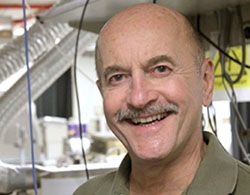
Hieftje survived these and other adventures in chemistry and graduated from high School in Zeeland, Michigan, in 1960 with a strong background in science and mathematics. His initial plan was to seek a degree in aeronautical engineering, but financial limitations dictated that he attend a local institution. Hope College, in Holland, Michigan, was a good option, but had no engineering program; their strengths were in pre-seminary and chemistry. Hieftje graduated from Hope with an A.B. degree in chemistry in 1964. While at Hope College, he was under a Hope College scholarship from 1960 to 1962, and a DuPont Scholarship in Chemistry from 1962 to 1964. He was able to obtain additional support for his studies by taking a position as a laboratory assistant for organic, analytical, and general chemistry, and by working nights and weekends as a laboratory technician, night watchman, and shoe salesman. In 1963, as a junior in college, he first became a member of the American Chemical Society. While at Hope, he performed research in synthetic organic chemistry under a well-known educator, Gerrit Van Zyl. Hieftje studied Grignard reactions and the linking of thiophene with several unsaturated aldehydes, all of which were intense lachrymators. One reaction that went astray emptied the Hope College chemistry building.
Van Zyl urged Hieftje to pursue graduate work, so Hieftje applied to the University of Illinois, but with a major in inorganic chemistry. However, a brief visit to the university revealed that the cost of housing was far more than Hieftje, now a husband and father, could provide. He was therefore urged by John Bailar, his intended advisor at Illinois, to apply to the Illinois State Geological Survey, run by a friend of Bailar’s. Hieftje received an offer as a research assistant in physical chemistry, and carried out research that yielded two publications: “Application of Continuous-Flow Apparatus to Thermal Decomposition and Sintering Studies,” (2) and “Rapid and Precise Determination of Carbon Dioxide from Carbonate-Containing Samples Using Modified Dynamic Sorption Apparatus,” (3) both in the foremost journal Analytical Chemistry.
While at the Geological Survey, Hieftje routinely attended seminars at Illinois, took the mandatory language exams, continued evening work as a shoe salesman, and had discussions with several faculty members, including Howard V. Malmstadt. The time with Malmstadt and his research group convinced Hieftje to join that group, and to major in analytical chemistry. He entered the University of Illinois in 1965, receiving a National Science Foundation (NSF) Traineeship in Chemistry, and a half-time teaching assistantship from 1965 to 1969; in 1969, he was elected to the Sigma Xi scientific honor society. In June of that year, he graduated with a PhD in chemistry, with a thesis entitled, “A Unique System for Use in Studying Flame Spectrometric Processes.” Hieftje credits Malmstadt with much of his philosophy regarding teaching, research, and service. Many others have been similarly influenced. Malmstadt revolutionized the study of instrumentation, beginning with a seminal 1963 textbook, Electronics for Scientists, which is still in print (4). Malmstadt’s doctoral students are among the most well-known academicians in the analytical sciences, and they include, in addition to Hieftje, James P. Avery, Ramon M. Barnes, Stanley R. Crouch, M. Bonner Denton, Willard W. Harrison, Gary Horlick, Harry L. Pardue, John P. Walters, James D. Winefordner, among others. The distinguished Malmstadt–Hieftje academic tree can be found online (5).
Left: Hieftje with instrumentation in graduate school at the University of Illinois (c. 1967); Right: Hieftje and Gary Horlick in graduate school (c. 1967). (Photos courtesy of Susan Hieftje.)
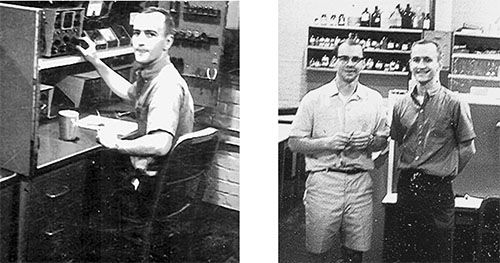
In his initial work in Malmstadt’s group, Hieftje pursued research on time-resolved high-voltage spark emission spectrometry, beginning work on designing and constructing an “ideal spark source.” Hieftje’s hearing never fully recovered from this work, and it was perhaps fortunate that the spark source did not survive the move to a newly constructed chemistry building. Malmstadt then invited Hieftje into his office to discuss a new device developed in the charged-particle laboratory at Illinois. That device, an “isolated droplet generator,” could be a perfect way to study events that occur to a single aerosol droplet in an analytical flame, such as those used in atomic absorption spectrometry (AAS). After an unsuccessful attempt at sending droplets into a conventional air-acetylene flame supported on an AA slot burner, other Malmstadt group members concluded that Hieftje would be the first 100-year continuous PhD student from Illinois. Hieftje was then pointed at a special burner devised by Kees Alkemade, where Malmstadt had spent a sabbatical. The result was a new combination that formed the basis of Hieftje’s doctoral research and many future activities. The first publication coauthored with Malmstadt, entitled, “A Unique System for Studying Flame Spectrometric Processes,” described the isolated droplet generator-flame combination and its use to measure droplet-desolvation rates in a flame (6). This work would lead to further fundamental studies of isolated droplets in desolvation and vapor-phase interactions within flames, one of Hieftje’s academic trademarks.
In September 1966, while working for the Illinois State Geological Survey, Hieftje co-authored a research paper presented at the 152nd National Meeting of the American Chemical Society in New York City (7). Three years later, Hieftje’s second publication with Malmstadt, on a more practical bent, came out in 1969, entitled, “A New Approach to Flame Spectrometric Analysis Utilizing Isolated Droplets of Sample Solution,” also published in Analytical Chemistry (8). Hieftje wrote of his time with Malmstadt (9):
To me, one of his most significant teachings was the importance of establishing and seeking an ideal, whether it be in the development of scientific instrumentation, solving an analytical problem, or establishing life-long goals. The ideal need not be, and in many cases should not be, achievable. Rather, it provides a fixed target, a benchmark for ongoing assessment.
Clearly, Hieftje took that lesson to heart over the course of his career.
Following graduation in 1969, Hieftje began his half-century-long teaching and research career exclusively at Indiana University. He became a full professor in 1977, and was named a Distinguished Professor in 1985. A year earlier, he had begun to be selected for highly significant awards, including the ANACHEM Award, the Lester W. Strock Medal, and the Meggers Award in 1984. Such prestigious awards would continue on nearly an annual basis through today (Table I). In 2018, Hieftje entered emeritus status at Indiana (10). As of the time of this article, Hieftje has been involved in 608 manuscript publications (https://www.researchgate.net lists 633 publications), 13 books, and 20 book chapters (Table II), 21 issued U.S. and international patents (Table III), and 27 named lectureships. He and his group have delivered over one thousand scientific presentations (11,12), and published in more than 45 different journal titles (Table IV). To date, 70 students have received doctorates under his direction; 30 have received master’s degrees, and a large number of undergraduates and visiting scientists have performed research in his laboratories-even high school students. In one of his most recent honors, Hieftje was elected a Fellow of the National Academy of Inventors in 2018 (13,14).
Gary Hieftje as an assistant professor at Indiana University in 1973. (Photo courtesy of Susan Hieftje.)
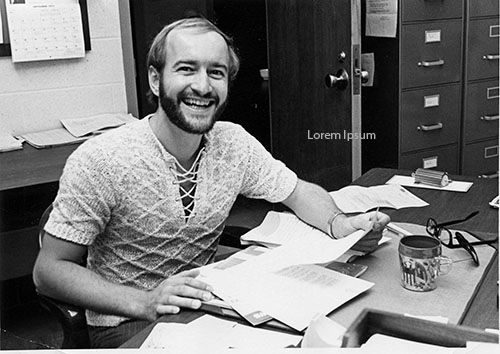
During his career, Hieftje has received numerous awards. In addition to those mentioned above, he has been the recipient of the Monie A. Ferst Award of Sigma Xi, the last Maurice F. Hasler Award from the Pittsburgh Conference, the ACS Award in Analytical Chemistry, the Robert Boyle Prize for Analytical Science from the Royal Society of Chemistry, and a Humboldt Research Award for senior U.S. scientists, among others. He is a fellow of the Indiana Academy of Science, the American Chemical Society, the American Association for the Advancement of Science, the Society for Applied Spectroscopy, and the Royal Society of Chemistry. He is a member of the American Society for Mass Spectrometry, and an honorary member of both the Society for Applied Spectroscopy and the Golden Key International Honor Society. For his teaching contributions, he has received the ACS Excellence in Teaching Award, the Monie A. Ferst Award from the Sigma Xi Society, the Tracy M. Sonneborn Teacher/Scholar Award from Indiana University, and the Indiana University Trustees Teaching Award, among others. He has received many other awards in his career, for teaching and education, for scientific research, for publications and presentations, and for inventions. Table I provides a more comprehensive list of his awards.
Prominent members of the Malmstadt group in 1980: (L to R) Bonner Denton, Gary Horlick, Gary Hieftje, James Winefordner, and Ramon Barnes. (Photo courtesy of Susan Hieftje.)
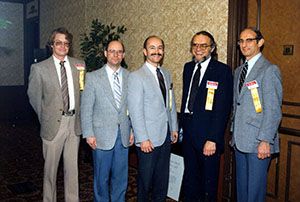
Immeasurable Impact
Assessing the impact of a scientist like Gary Hieftje is not easy. For help, we asked a number of people what his greatest contributions were. Almost everyone found it very hard to answer that question.
“They are impossible to list!” says Richard Russo, a former graduate student and a scientist at Lawrence Berkeley National Laboratory, in Berkeley, California. When pressed to be specific, he cited a 1969 paper coauthored with Malmstadt when Hieftje first was studying the use of a controlled stream of uniform-sized droplets for atomization in flame spectrometry (8). “This was the foundation of Hieftje’s early career and grounds for tenure,” Russo said.
“Gary’s career has spanned such a long time and such a wide range of analytical techniques that it is difficult to rank his contributions,” agrees Paul Farnsworth, a former postdoctoral researcher, and now retired from his role as a professor at Brigham Young University. But he points to Hieftje’s very early work on droplet and particle evaporation in flames. “The experiments were elegant, and they produced results that have had an enduring impact,” Farnsworth explains. Later, this work was used in the fundamental study of analyte behavior in the inductively coupled plasma (ICP), by Kay Niemax and others.
Radislav A. Potyrailo, a former graduate student and currently a principal scientist at GE Research in Niskayuna, New York, puts Hieftje’s instrumental developments at the top of the list. “He propelled analytical instrumentation science to new heights,” he says. “His theoretical and experimental discoveries opened a new era in elemental and molecular analysis.”
Scott D. Tanner, retired from roles at Sciex, the University of Toronto, and DVS Sciences, was particularly impressed with Hieftje’s papers on the understanding of plasma characteristics, ion sampling, and ion optics, intelligent investigations into the fundamentals of ion and electron flow using optical interrogation methods, and the use of time-of-flight (TOF) mass spectrometry in plasma mass spectrometry. Tanner also thinks Hieftje’s work developing a useful array detector was brilliant, yet underappreciated. “The future for this technology is still ahead of us,” he said.
“Gary is always up to and relishes a challenge,” says John Olesik, another former postdoctoral researcher and currently the director of the Trace Element Research Laboratory at The Ohio State University. That willingness to take on hard projects, he says, led to several of his most important breakthroughs in designing and building new instruments-projects that often required years and several postdoctoral researchers and students just to obtain the first successful signals. As an example, Olesik points to the work on single-droplet measurements in flames that Hieftje started as a graduate student and continued as a professor. “Many of us spent hours staring into a strobe lamp in Gary’s lab trying to get a droplet generator to work just right,” he said. That dedication by Hieftje and his group resulted in new insights into desolvation, vaporization, and atomization in flames, as well as other developments, such as instruments for Thomson scattering; the first ICP-TOF-MS instrument, the first ICP-sector field MS instrument with an imaging detector, and the first distance-of-flight (DOF) MS system.
Norbert Jakubowski, the former head of the division of Inorganic Trace Analysis at the German Federal Institute for Materials Research and Testing (BAM), agrees that instrumental innovations have to be named among the major contributions of the Hieftje group. Among those innovations, he includes pioneering work in ICP-TOF-MS as a simultaneous multielement method, improvements of ICP-MS, DOF-MS (and applications of coupling these instruments with electrothermal vaporization [ETV]), and design of a glow discharge ion source. Jakubowski also cites the award-winning work using a Mattauch-Herzog geometry for simultaneous detection of all ions using multiple Faraday detectors. “Gary got a DOE [Department of Energy] grant together with Dave Koppenaal and Bonner Denton to develop an electronic photoplate to detect ions simultaneously focused in the focal plane of the instrument,” Jakubowski says. “The instrument is commercially available and received an R&D 100 award.”
Alfredo Sanz-Medel, a friend and colleague and a professor at the University of Oviedo in Spain, considers Hieftje a “visionary” for reliable instrumental chemical analysis. “Without a doubt, Gary has been at the forefront of modern analytical science, with a special and pivotal role in defending the need for fundamental study and understanding of our analytical tools,” he says.
Ron Hites, a distinguished professor at Indiana University, points to the remarkable breadth of Hieftje’s work, ranging from droplet generation to optical spectroscopy to ICP generation and finally to mass spectrometry. “He has moved smoothly from one to the other and has made groundbreaking contributions in all of these areas,” Hites says. “Throughout his career, his approach can be described as Edisonian, and I know that, like Edison, Gary was particularly proud of his several patents.”
Maria Montes-Bayón, a professor of analytical chemistry at the University of Oviedo, highlights another of Hieftje’s talents. While noting that his scientific productivity has been “amazing,” she is also particularly impressed by his communication skills. “There is always some impressive science to learn in all his talks, and lately, he has also been including wise advice to new students and senior scientists,” she says. “He is getting better over time.”
Sanz-Medel agrees. “Gary has always been an outstanding speaker, in such a way that his plenaries have always produced great expectation and been generously attended by analytical colleagues worldwide,” he said.
“Dr. Hieftje’s contributions to science and the community are countless,” says Carsten Engelhard, a former post-doctoral researcher who is a professor at the University of Siegen in Germany. “Besides the brilliant scientific work in the lab on fundamentals, instrumentation, and new methods, it is also the interactions with other people that make him special,” he adds. “He leads by example, and has inspired many of those within his circle to stay in science and to pursue independent careers.”
George Chan, a former graduate student, and now a research scientist at Lawrence Berkeley National Laboratory, says that Hieftje’s greatest contribution was in his training of the next generation of scientists. “As one of his students, I can say from personal experience that the training that I received under his mentorship was superb,” he says. That training, Chan adds, was not just scientific knowledge related to his dissertation topic, but more importantly was about “the attitude towards scientific research, critical thinking, and ability to perform independent research.” Chan still remembers his first encounter with Hieftje as a potential graduate student. “I asked him about the graduation requirements for a PhD in his group,” Chan recalls. “His answer was ‘Not by number of papers, but when you show me you can do independent research.’”
Robert Lodder, a former graduate student who is now a professor at the University of Kentucky College of Pharmacy, shares that sentiment. “Of course, Gary has won just about every analytical chemistry award there is for his different contributions to science,” he says, “But his greatest contribution is probably his students.” Hieftje trained and sent forth a large number of newly minted scientists who are making “all kinds of contributions,” Lodder says.
An early version of the inductively-coupled plasma (ICP) in the laboratory. The ICP was a major research area of Hieftje’s laboratory, both in applications in spectrochemistry and in the fundamental study of the plasma. (Photo courtesy of Susan Hieftje.)
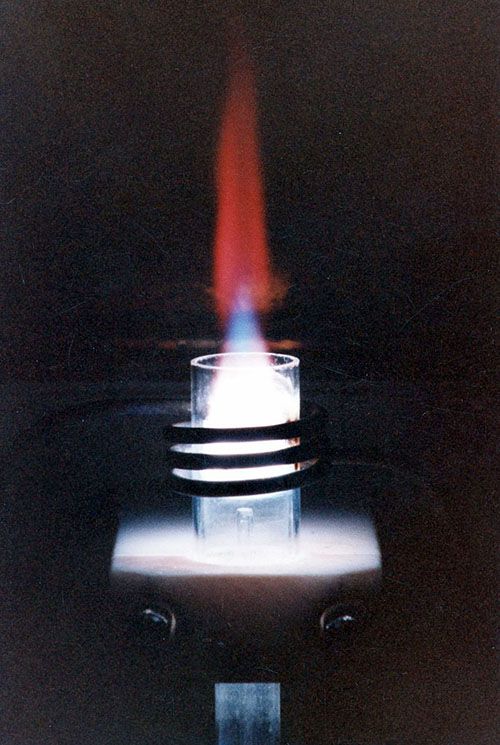
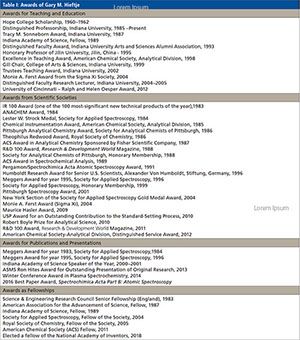
Hieftje as Educator
Indeed, Hieftje’s impact as an educator has been enormous. “A remarkable aspect of Professor Hieftje’s talents refers to his high human values as an academic educator,” says Sanz-Medel. “His honesty and his closeness to the students, PhDs, and researchers working under his supervision are remarkable,” Sanz-Medel says. “He was proud of them, close to them, and helpful to them, and he always emphasized their great contribution to the whole process of making analytical science.”
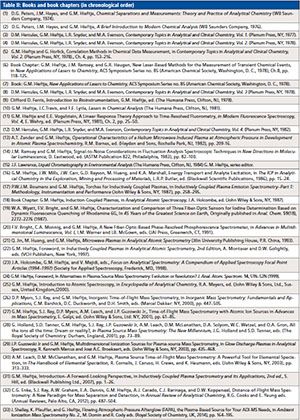
Steven Ray, a former graduate student and the Winkler Assistant Professor of Chemistry at State University of New York at Buffalo, says that Hieftje has a gift for explaining complex concepts clearly, but that he also always put a lot of effort into his teaching. “Gary’s classroom lectures are always smooth, casual, and appear effortless, but this belies the fact that they are the result of a great deal of preparation and continual honing,” Ray said in a recent tribute article (12). He said that Hieftje “is a ‘sceptical chymist’ in the best sense,” a term referring to Robert Boyle’s 1661 monograph, The Sceptical Chymist: or Chymico-Physical Doubts & Paradoxes. In this book, Boyle expounds on the importance of reproducible results, clear explanations, avoidance of tech-speak, and the essential ingredient of experimentally produced information, rather than ungrounded (or emotional) speculation. Boyle has been referred to as the founder of modern analytical chemistry.
Praise for Hieftje’s teaching is echoed by all his former graduate students, post-doctoral researchers, and collaborators. His influence on undergraduate education was expanded through the noted textbook, Chemical Separations and Measurements by Peters, Hayes, and Hieftje. The book has formed the basis for many introductory undergraduate courses in analytical chemistry.
For many, what made such a strong impression was not just specific scientific concepts they learned, but rather much bigger lessons about the approach one should take to science. “Hieftje taught me through example that science was not a job, but a life or passion,” says Russo, adding that Hieftje really frowned at mistakes. “He pushed you to work hard to get things right-not just the science, but a detailed description of the science through excellent writing and speaking skills. That is very valuable for a career in science.” Russo says he cannot think of a more dedicated and professional person and is grateful for his time with Hieftje. “Gary’s hard work paved the path for many students and other professionals to have successful careers,” Russo concludes.
Lodder says the things he remembers most-and still repeats today to his own students-were offhand comments Hieftje made. “These are little things he might not even remember saying now, but I was impressed enough back then to go back to my office and write them down,” Lodder says. For example, after Hieftje had won another award, someone remarked that he had become pretty famous. “He responded that the most you could really hope for as a scientist was to become famous among a group of 200 of your closest friends.”
Lodder also remembers Hieftje’s advice about how much data to gather. “Gary would often remind us that it is pretty easy to get 80% of the data you need from an experiment to make the perfect publication,” Lodder recalls. “The next 10% is hard to get and going after the last 10% can be fatal to your career.” The lesson, he said, was to know when to say “when.”
Another bit of wisdom Lodder remembers was just to get into the laboratory. “Sometimes we would get into long discussions in planning experiments, and he would remind us that ‘an ounce of data is worth a pound of informed speculation.’”
Engelhard first came across Hieftje’s name as an undergraduate at Münster University, because the Smith–Hieftje method for AA background correction is covered in all German analytical chemistry textbooks. A couple of years later Engelhard was scheduled to visit Indiana for a summer project. “I was scared to death to show up in his lab, because he was a giant in the field and I was just a second-year PhD student,” Engelhard says. So before the visit, he studied day and night, and printed many of Hieftje’s papers, filling half his suitcase with literature. To his amazement, when he first walked into his new mentor’s office, all the weight came off his shoulders. “He was the nicest giant I have ever met,” Engelhard says. “He told me, ‘When you really enjoy the work that you are doing, it is not work, it is fun.’”
“Because of his personality, Gary inspired people around him (students, post-docs, visiting scientists, and colleagues) to learn about science, and to fall in love with doing science with passion and deep understanding,” Potyrailo says. “He viewed his students and post-docs as peers with whom he shared his ideas in order to grow these ideas into the results that were impressive and impactful to the scientific community.” And while providing leadership, he let the members of his group develop. “He was providing us true research freedom, yet guiding us along the way,” Potyrailo concludes.
While providing all this guidance, Hieftje also brought tremendous joy to his work and his group. “Dr. Hieftje has always shown that you can perform brilliant science and have fun at the same time,” says Engelhard. Gerardo Gamez, a former graduate student and an Assistant Professor at Texas Tech University, agrees. “Heef has an infectious joie de vie with a work-hard-play-hard attitude to match,” he says, referring to the professor by an affectionate nickname.
Montes-Bayón says that Hieftje’s enthusiasm can infect even students from other analytical chemistry disciplines. When she was helping organize a Summer University program at Humboldt University in Berlin, she invited several senior scientists to give lectures. Even though very few of the students were involved in plasma spectroscopy as their main research discipline, the students voted Hieftje’s part of the symposium as the most interesting. “He has an impressive way of interacting with young generations,” she said.
Hieftje’s students are now producing scientific “grandchildren,” as many of his graduates have positions in academic institutions. Some of these include: Mike Blades (University of British Columbia), Charles B. Boss (North Carolina State University), Frank Bright (SUNY at Buffalo), Steven Buchwald (Massachusetts Institute of Technology), Mary Carroll (Union College), Jose Costa-Fernandez (University of Oviedo), Carsten Engelhard (University of Siegen), Paul Farnsworth (Brigham Young University), Gerardo Gamez (Texas Tech University), Alex Gundlach-Graham (Iowa State University), Robert Lodder (University of Kentucky), John Olesik (Ohio State University), J. Michael Ramsey (University of North Carolina at Chapel Hill), Steve Ray (SUNY at Buffalo), Jacob Shelley (Rensselaer Polytechnic Institute), and Mike Webb (University of North Carolina at Wilmington).

Hieftje as Researcher
Hieftje is famous for his prolific ideas for research projects. When Steve Ray was a fledgling graduate student, Hieftje handed him a 3âcm thick document containing abstracts of current research projects that the group was engaged in, explaining that Ray was welcome to join any of them; if not, there was an even thicker file in the cabinet filled with notes about research ideas that Hieftje was interested in exploring. If Ray did not find something interesting in the current direction of the laboratory, the idea went, he could probably find a topic in that file (12). “He has so many ideas, and so many really good ideas,” Ray says “I have always greatly admired his creative insight.”
Five decades of research in the Hieftje laboratory have taken multiple directions, and resulted in important breakthroughs in chemical instrumentation and measurement science, resulting in a world-renowned reputation as well as academic progeny, producing further technical contributions each year.
The early years of research involving droplets developed into a fundamental study of atom formation in analytical flames and later plasmas. Then research into signal-to-noise enhancement and the use of computer algorithms to improve instrument performance and signal processing became a topic of interest. Then came the development of several devices for direct digital automatic titration.
Hieftje became well known for developments in signal-to-noise theory, modulation approaches for analytical chemistry measurements, and the use of computers in the laboratory.
The Hieftje research group in 2008.
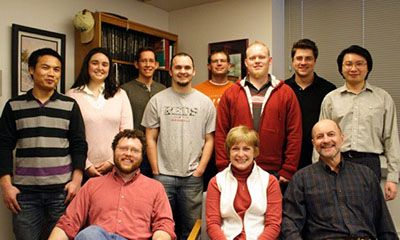
Later, his group delved into selection of source-modulation waveforms for improved signal-to-noise ratio in AAS and the use of correlation analysis in flame AAS. This series of experiments then led to marked improvements and better understanding of flame spectrometry. In the mid-1970s, a computer-controlled microwave discharge emission spectrometer was designed and studied. Aspects of computer control and data processing to maximize signal-to-noise ratios became study topics in this era. Later, in 1976, the study of flame emission, atomic absorption, and atomic fluorescence were evaluated, along with methods for automatic background correction. Other studies resulted in publications on the subjects of laser mode noise, picosecond luminescence lifetimes, spectral and noise characteristics of analytical flame-based instrumentation, and microwave-induced plasmas. Later in the 1970s, microwave plasmas and signal processing methods were continuously developed for instrument improvement.
In 1978 a publication on computer identification of infrared (IR) spectra by correlation-based file searching was released. This was followed by work in laser-induced fluorescence, the development of miniature or optimized ICP torches for atomic emission spectrometry, and a “microarc” atmospheric-pressure glow discharge. Flame work was continued and then research in time-resolved fluorimetry, mode-locked laser measurements, and miniature ICP background signals.
More fundamental studies of atoms and vaporization physics in helium-oxygen-acetylene and air-acetylene flames was continued as a research theme. Microwave-induced plasmas, reduction of spectral interference, and gas composition of acetylene flames, and new ICP sources for atomic emission spectrometry were researched. More flames, lasers, and microwaves were used in pursuit of improved methods and instrumentation.
By the mid-1980s, Hieftje and his group had firmly established a prominent reputation in the analytical sciences and spectroscopy, and increasingly received accolades and invitations to participate in the broader scientific community. The Hieftje group researched and published over a diverse range of technologies in the analytical chemistry field that might be referred to as “the science of instrumentation and measurements” (15). The myriad techniques they investigated is mind boggling. It includes the entire history of elemental analysis techniques and sometimes moved into the scope of molecular analysis as well. Hieftje and his students prolifically published and presented papers on flame and furnace AAS, spark (emission) spectrometry, ICP–optical emission spectrometry (ICP-OES), glow discharge–atomic emission spectrometry (GD-AES), ICP-MS, ICP-TOF-MS, laser-induced breakdown spectroscopy (LIBS), and laser ablation molecular isotopic spectrometry (LAMIS). Hieftje and his students probed into microwave induced plasma-atomic emission spectrometry (MIP-AES), time-resolved fluorescence, near infrared reflectance analysis (NIRA), molecular luminescence, ion chromatography, frequency-domain fluorimetry, phase-resolved phosphorescence spectrometry, ultraviolet-visible (UV-vis) and IR spectroscopy, supercritical fluid chromatography (SFC), Shpol’skii spectroscopy, photodiode-array spectrometry, flow-injection analysis (FIA), laser-light scattering, excitation-emission fluorescence-polarization, thin-layer chromatography (TLC), molecular evanescent-wave absorption spectra, near-ultraviolet spectroscopy, evanescent-wave refractometry, remote and spatially distributed fiber-optic sensing, use of aptamers for biochemical measurement, ion mobility spectrometry, and acousto-optical spectrometry.
Hieftje graduate students and post-doctoral researchers delved into learning the fundamental aspects of such phenomena as gas flow dynamics, droplet generation, solute particle vaporization, plasma formation and properties, microwaves, fluorescence interference, flame morphology, sample modulation, noise sources, frequency domain studies, fluorescence lifetimes, correlation methods, multivariate calibration and modeling, fluorescence quenching, and ion sensing. Studies were launched into atomic and molecular absorption and emission, Thomson scattering to determine electron concentrations and temperatures in the ICP, fractals, ion redistribution and separation in ICP, atomization mechanisms, acoustic noise, matrix interferences, charge transfer excitation, laser pulse width and coherence times, low-temperature phosphorescence, radioluminescence, and laser ablation.
Simultaneously, the Hieftje laboratory began advancing the design and development of various instrument-related components, including lasers, atomic and molecular sources, discrete detectors, array detectors, liquid crystals, electronics, optical elements, computer control systems, data processing algorithms, signal-to-noise improvement, interference removal, spatially resolved analyte imaging, pattern recognition, fiber optics, miniaturization, automation, focal-plane cameras, and more.
Hieftje and his group also applied these techniques to a wide range of problems across elemental and molecular analysis including metallomics, inorganic mass spectrometry, elemental analysis, molecular analysis, single-tablet pharmaceutical analysis, trace metals, nonmetals, atmospheric humidity sensing, determining electron concentrations, cholesterol and blood constituents, simultaneous determination of specific ions, classification of alloys, chemical and physical characteristics of polymers, solute vaporization rates in analytical flames, kinetic information, monitoring the influent or effluent from a waste-destruction processes, non-metals in gas-phase samples, vapor sensing, isotope ratios and abundance, enantiomer determination, chlorine in halogenated hydrocarbon vapors, phosphorus as vanadomolybdophosphoric acid, speciation analysis, multielement analysis of aluminum ceramic powders, veterinary drug residues in foodstuffs, gas phase samples, and more.
The Hieftje group has even worked on such topics as the surfatron and the The Quantile BEAST, the former term meaning a surface-wave induced plasma source for atomic emission spectrometry, and the latter an acronym for Bootstrap Error Adjusted Single-sample Technique, a chemometric method for detecting one or more “false” or unrepresentative samples in a multivariate calibration training set.
Hieftje during his heritage lecture at the 2019 European Winter Conference in Pau, France. (Photo courtesy of Carsten Engelhard.)
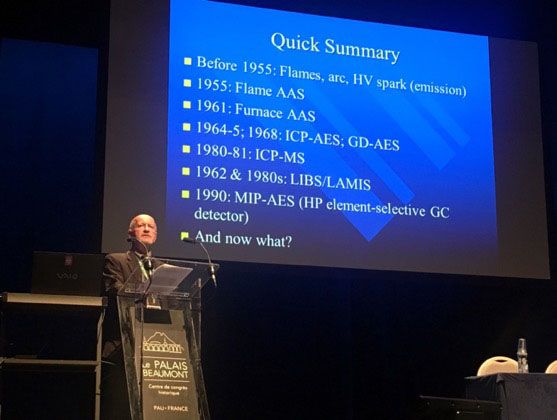
Hieftje as Inventor
All that research led to multiple inventions, winning Hieftje a place as an elected Fellow of the National Academy of Inventors. His inventions encompass many disciplines in fields such as chemistry, biology, physics, computer science and chemometrics, medicine, environmental science, geology, and multiple applications of analytical chemistry.
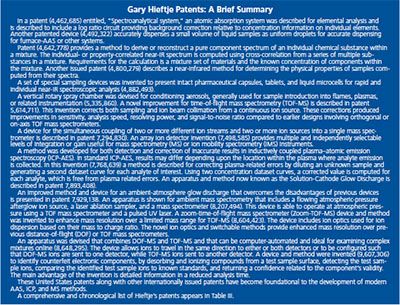
Hieftje at the Royal Society of Chemistry, in London, UK, with members of the editorial board of the Journal of Analytical Atomic Spectroscopy in 2015. (Photo courtesy of Carsten Engelhard.)

“Gary Hieftje has been one of the most creative and productive analytical chemists on the planet over the past half century,” says Michael Blades, a former postdoctoral researcher, and professor emeritus of chemistry at the University of British Columbia, in Canada. Blades noted that Hieftje is best known for his contributions to the advancement of analytical instrumentation. “Notable among his contributions are Smith-Hieftje background correction for atomic absorption, the development of microwave plasma systems and mini-torches for ICP, and jointly with others, the development of focal plane array detectors for ICP–MS.”
José Broekaert, a long-time collaborator and friend, and the chair of analytical chemistry at the Universität Hamburg in Germany, also remarked on some particular patented Hieftje inventions; in addition to the Smith-Hieftje technique for AAS, he points to the Wu-Hieftje spray chamber for ICP-spectrometry, TOF-ICP-MS, and distance-of-flight (DOF)-MS.
Hieftje’s patented inventions have become foundational to the development of modern AAS, ICP, and MS methods. A description of his issued U.S. and international patents appears in the sidebar, with a comprehensive and chronological list appearing in Table III.
Hieftje as Mentor
Hieftje is well known for mentoring students, postdoctoral researchers, and coworkers.
That mentoring includes creating a sense of community, even of family, notes Eyal Elish, a researcher in the Analytical Chemistry Department at the Negeve Nuclear Research Center (NRCN) in Israel. Elish spent a one-year sabbatical with the Hieftje group from 2009 into 2010, which he describes as “a wonderful year,” thanks to both Hieftje and his wife Susan. “Heef took care not only to demand hard work in the group, but also to have rich social events like group parties, trips, dinners and more,” Elish said, noting that he and his family have returned several times to visit the group in Bloomington. “Heef and Susan will always be in our hearts,” he adds.
A photo of “the wall” on which Gary Hieftje had all his visitors leave a signature, during a visit by Paul Farnsworth to Indiana in 2009. (Photo courtesy of Paul Farnsworth.)
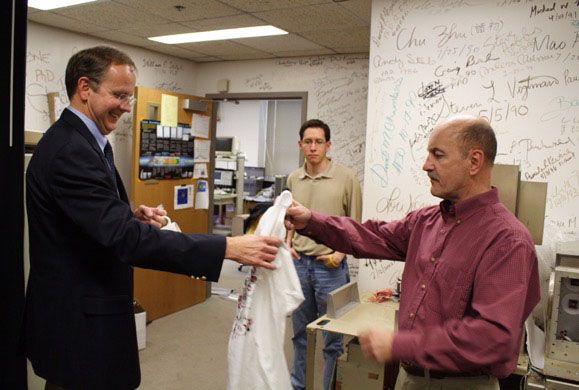
Olesik agrees. “Gary’s research group is, and always will be, a family because of the culture he fostered,” he says. “He provided life-changing opportunities to so many students, postdocs, and collaborators while supporting them all.”
“Such an environment fostered frequent discussions that produced some of the most notable research from his group, like solution-cathode glow discharge, and distance-of-flight MS, and a lasting community of hard-working, collegial analytical chemists,” says Jacob Shelley, the Alan Paul Schulz Career Development Professor of Chemistry at Rensselaer Polytechnic Institute. “This point is illustrated by the large number of Hieftje group members who have gone on to independent academic careers to build familial research groups as Heef showed us and as Howard Malmstadt had shown him.”
Volker Hoffmann of the Leibniz Institute for Solid State and Materials Research in Dresden, Germany, saw that first hand when he spent four months in the Hieftje group in 2001. He was interested in seeing how research was conducted in this famous laboratory; what he found was a friendly and open atmosphere where everyone tried to support the work of the others. Sharing instrumentation and discussing problems at coffee breaks were part of the routine, and through those conversations, Hieftje saw how the work was going. “If a part was missing or help was needed, for example, for special software or preparation of mechanical parts in the workshop, Gary organized this support,” Hoffmann says. “This support and friendship led to the wish of all group members to contribute themselves as much as possible to the success of all.”
Shelley also emphasized the importance of the conversations over coffee. “These discussions pushed us all to be better scientists and better human beings,” he says. “We discussed our latest results, devised future research plans, bonded with one another, game-planned the next flag football game, celebrated accomplishments, and grieved lost friends, family, and colleagues.”
Gamez also appreciated Hieftje’s mentoring. “I remember very fondly my time as a student in his laboratory which to me was like a huge instrument development playground,” he says. “We had the liberty to try whatever idea that came to us. I never heard him say ‘that is never going to work.’ He always encouraged us to try it.”
Hieftje’s mentoring also includes wise advice and aphorisms. A favorite of Potyrailo’s was, “One day in the library saves one year in the lab”-wisdom he has found valuable throughout his career. Potyrailo says he also learned the importance of collaborating with other research teams, which he had several opportunities to do while a graduate student.
Lodder also gained important career advice from Hieftje. When first looking at academic positions, Lodder asked his mentor what to look for in a university. He recalls Hieftje’s response: “The quality of the students. Interview them carefully everywhere you go, because they will determine your success.” Lodder then asked what was the most important skill a new faculty member could have. The answer was “The ability to do two things at once and do them well.” What about three things? Lodder asked. Hieftje’s reply: “No one can do three things at once, and do them well.” All this advice, Lodder said, has served him-and his own students-extremely well for over 30 years.
Hieftje’s enthusiastic mentoring even reached younger students. Stephen L. Buchwald, the Camille Dreyfus Professor of Chemistry and the associate head of chemistry at the Massachusetts Institute of Technology, spent a summer in Hieftje’s laboratory while still in high school, as part of a National Science Foundation summer science program. That experience had a profound impact on him and led to his becoming a chemist. “Gary showed me how exciting science is and how much fun one could have being part of a team,” Buchwald says “I have always been impressed that he took so much time, during his busy pretenure period, to encourage a high school student. Forty-seven years later, I am still doing chemistry.”
Hieftje didn’t limit his encouragement to his own group. “Gary has been a mentor to all of us in the analytical community,” says Vahid Majidi, a director at Savannah River National Laboratory, who was never part of Hieftje’s laboratory. “I have known and interacted with him as a graduate student (not his), as a postdoc (not his), and as a researcher in different institutions,” says Majidi. “In every instance, Gary has been caring, deeply insightful, scientifically brilliant, and generous with his time.”
Hieftje at the Royal Society of Chemistry, in London, UK, with members of the editorial board of the Journal of Analytical Atomic Spectroscopy in 2015. (Photo courtesy of Carsten Engelhard.)

Farnsworth retired a little over a year ago, and as he cleaned out his office, he was repeatedly struck by the positive effect Hieftje had on his career. “He recommended me to conference organizers to speak in symposia and to editors to write papers,” he says. “He generously let me take ideas that I picked during my postdoc at Indiana to lay the foundation of my research program at BYU.” Farnsworth suggests that his experience was not unique-that Hieftje unfailingly supported former postdoctoral researchers and graduate students as they launched into their careers. “Gary has been a model advisor throughout his career, and I consider myself fortunate to have spent time in his lab,” Farnsworth says.
“Gary’s enthusiastic mentoring of his students is a remarkable human value that stands out among his brilliant research achievements and the great impact of his work on the progress of our field of analytical spectroscopy,” concludes Sanz-Medel.
Hieftje as Colleague and Friend
Hieftje’s positive influence extended to all around him. “For me, Gary Hieftje was an excellent colleague and friend throughout our professional life,” says Broekaert. “I was glad to be a guest scientist many times in his research group, and to have him visit my research group, be it in Dortmund, Leipzig, or Hamburg. He also was a friend for me from house to house.”
In some cases, his daring work spurred on others. “His work on the development of new instrumentation for elemental analysis using atomic absorption and fluorescence was quite inspirational and made me more confident that chemical analysis was something I wanted to do,” says Richard N. Zare, the Marguerite Blake Wilbur Professor in Natural Science in the Department of Chemistry at Stanford University.
Chris Enke, a professor emeritus at Michigan State University and the University of New Mexico, had a wonderful collaboration with Hieftje on DOF-MS. He notes that Hieftje and his team made everything work beautifully, including securing funding and having great students and staff to work on the project. “It was a very pleasant and successful collaboration resulting in a couple of theses, many papers (one of which won the ASMS paper of the year award) and a few patents,” Enke says. “It was altogether a great experience.”
“In my arrogance, I sometimes thought of Gary as a competitor of mine,” says Tanner. “In reality, he always was and will be a guiding light for me, and a supporter and a friend.”
“How to characterize one of my best friends in the US?” ponders Jakubowski. “Gary is a brilliant brain, professional pragmatist, innovative engineer, practical physicist, and super-spectroscopist with keen knowledge of atomic and mass spectroscopy-a clever chemist looking always for alternative analytical answers to burning questions. He is also a talented teacher with many humoristic and sometimes provocative and sober slogans and ambitious animations,” he says. “Gary was my personal hero in spectroscopy, convincing in presentations by his charming charisma and a smart smile for everybody.”

An Enduring Legacy
Although Gary Hieftje has formally retired, his impact will live on. Through his research developments, his inventions, and his role as an educator, mentor, and colleague, he has already made a lasting impact on the field of analytical chemistry. That influence will endure for generations of analytical chemists still to come.
Acknowledgments
The Spectroscopy editorial staff extends our appreciation to the following individuals for sharing their personal comments and for collaborating on this project: Susan Hieftje, Steven Ray, Alfredo Sanz-Medel, Carsten Engelhard, Chris Enke, Eyal Elish, George Chan, Gerardo Gamez, Jacob Shelley, John Olesik, Jose Broekaert, Maria Montes-Bayon; Mikael Blades, Norbert Jakubowski, Paul Farnsworth, Radislav Potyrailo, Richard Zare, Richard Russo, Robert Lodder, Ron Hites, Scott Tanner, Steven Buchwald, Vahid Majidi, and Volker Hoffmann.
References
- “Laboratory for Spectrochemistry: Gary M. Hieftje Research Group.” http://www.indiana.edu/~gmhlab/
- J. Thomas Jr., G.M. Hieftje, and D.E. Orlopp, Anal. Chem.37(6), 762–763 (1965).
- J. Thomas Jr. and G.M. Hieftje, Anal. Chem.38(3), 500–503 (1966).
- H.V. Malmstadt, C.H. Enke, and S.R. Crouch, Instrumentation For Scientists Series, Electronic Measurements For Scientists (W. A. Benjamin, New York, New York, 1974). ISBN 10: 0805369023/ISBN 13: 9780805369021
- The Malmstadt–Hieftje academic tree, URL is found at https://academictree.org/chemistry/tree.php?pid=55000
- G.M. Hieftje and H.V. Malmstadt, Anal. Chem.40(12), 1860–1867 (1968).
- J. Thomas Jr., G.S. Benson, and G.M. Hieftje, Measurement of the Surface Areas of Coals from the Dynamic Sorption of Carbon Dioxide in 152 National Meeting of the ACS, New York, NY, September. Illinois State Geological Survey, # RPR1966-C, 1–8, (1966).
- G.M. Hieftje and H.V. Malmstadt, Anal. Chem.41(13), 1735–1744, (1969).
- S.R. Crouch, C.G. Enke, J.P. Walters, and G.M. Hieftje, Appl. Spectrosc. 58(6), 165A–172A (2004).
- “Gary Hieftje :Department of Chemistry.” URL is found at https://www.chem.indiana.edu/faculty/gary-hieftje/
- Hieftje, Gary M. “Publications.” Laboratory for Spectrochemistry: The Gary M Hieftje Research Group, Indiana University Chemistry Department, URL is found at www.indiana.edu/~gmhlab/publications.html.
- S.J. Ray, Spectrochim. Acta B76,14–15 (2012).
- “National Academy of Inventors announces Fellows”, URL is found at https://www.prnewswire.com/news-releases/national-academy-of-inventors-announces-2018-fellows-300763222.html?tc=eml_cleartime
- “Indiana University press release”, URL is found at URL: https://news.iu.edu/stories/2018/12/iub/releases/18-national-academy-inventors-elects-chemist-hieftje-as-fellow.html
- G.M. Hieftje, Anal. Chem.72(9), 309A, (2000).
Jerome Workman, Jr. is the Senior Technical Editor of Spectroscopy and Laura Bush is the Editorial Director. Direct correspondence to lbush@mmhgroup.com.
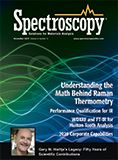
New Study Reveals Insights into Phenol’s Behavior in Ice
April 16th 2025A new study published in Spectrochimica Acta Part A by Dominik Heger and colleagues at Masaryk University reveals that phenol's photophysical properties change significantly when frozen, potentially enabling its breakdown by sunlight in icy environments.
Advanced Raman Spectroscopy Method Boosts Precision in Drug Component Detection
April 7th 2025Researchers in China have developed a rapid, non-destructive Raman spectroscopy method that accurately detects active components in complex drug formulations by combining advanced algorithms to eliminate noise and fluorescence interference.